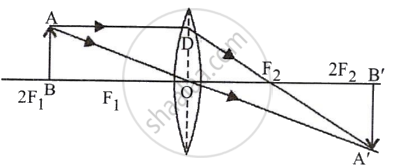Advertisements
Advertisements
प्रश्न
A converging lens forms the image of an object placed in front of it, beyond 2F2 of the lens. Draw a ray diagram to show the formation of the image.
उत्तर

APPEARS IN
संबंधित प्रश्न
The diagram given alongside shows a ray of light entering a rectangular block of glass.
(a) Copy the diagram and draw the normal at the point of entry.
(b) Draw the approximate path of the ray of light through the glass block and out of the other side.
An object 4 cm high is placed at a distance of 10 cm from a convex lens of focal length 20 cm. Find the position, nature and size of the image.
A convex lens of focal length 15 cm produces a magnification of +4. The object is placed:
(a) at a distance of 15 cm
(b) between 15 cm and 30 cm
(c) at less than 15 cm
(d) beyond 30 cm
Complete the following sentence.
A long-sighted person cannot see ........... objects clearly. Long-sightedness can be corrected by using .............. lenses.
For which position of the object does a convex lens form a virtual and erect image? Explain with the help of a ray diagram.
How will you decide whether a given piece of glass is a concave lens, convex lens, or a plane glass plate?
In the figure given below L is a convex lens, M is a plane mirror and S is a point source of light. Rays of light from the source S return to their point of origin. Complete the ray diagram to show this. What is the point S called?

How will you determine the focal length of a convex lens by the plane mirror method?
Find the odd one out and give its explanation.
Differentiate convex lens and concave lens.
